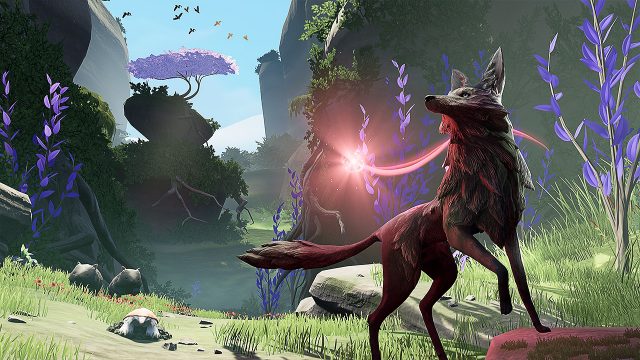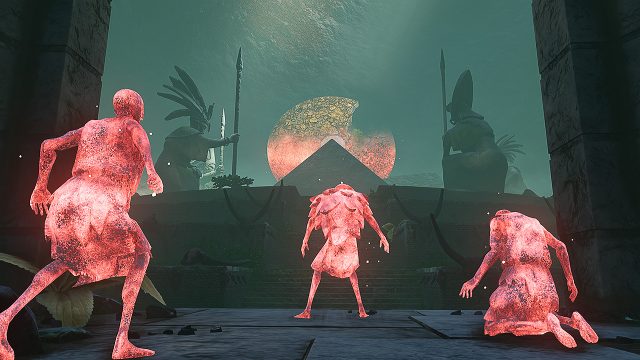Fun gameplay but ultimately unspectacular; pretty visuals are sumptuous and arresting; variety of animals to switch between adds some spark to the action
Storyline is largely rote, but the game revolves around it, so it stands out as being so-so; navigation can become tricky, especially if played without guidance from the game; performance hiccups abound and are distracting
Adventure games are tricky to pull off when they hinge upon a couple of key gimmicks to succeed. The Legend of Zelda: Breath of the Wild made a big deal of its open world, allowing players multiple ways to approach different puzzles and challenges. Splatoon bet the farm on players enjoying multiplayer gameplay that places the focus largely on spraying the ground with ink over going out and blasting opponents. While those two examples are of games that wildly succeeded at their design goals, Lost Ember strives to bring its pieces together into a satisfying whole and mostly does so—with some caveats.
There are two main conceits in Lost Ember: swapping between different animals to traverse the game world and the delivery of the narrative. Starting first with the body swapping, Lost Ember allows players to transition the main character, a spirit seeking to rediscover its identity, between different animals. From wolf to bird to fish, players are able to hop into a new form and reach new areas within the game world. Unfortunately, this swapping mechanic works from a technical standpoint but doesn’t get beyond the surface with it.
Part of the reason this switching mechanic feels a tad underwhelming is that Lost Ember is content with shuttling players from point A to B with not a lot in between to compel straying from the road in front of them. Lost Ember can come across as overly linear at times, which makes switching between animals less impactful. Getting to each objective is really the meat and potatoes of the game but to the detriment of exploring. Linearity is no sin if the gameplay makes up for a lack of freedom, but in Lost Ember’s case it can come up a bit short. There are some moments that really stand out, though, especially a segment where the player shoots down from a great height into a pool of water below. Lost Ember would have benefited from more moments like this.
Moving on now to the narrative, mileage will vary here in regards to how much it will matter to the player. Arguably, Lost Ember’s story can come across as rote, particularly once the second half of the game is reached. More seasoned players will likely see the twists and turns coming well ahead of when they’re supposed to, and that can make unraveling the narrative a chore when it shouldn’t be. That said, I still enjoyed the story even if it wasn’t anything I didn’t see coming. How much the story “clicks” or connects with players is, again, going to depend entirely on the player and their tastes.
Navigation can also be problematic in Lost Ember. There’s a choice to play the game without prompts or direction, but even without that option checked off, it can be easy to become disoriented and lost. This can lead to time wasted backtracking unnecessarily. Since the narrative is placed front and center in Lost Ember, one can assume that the presence of a dedicated navigation system on-screen might have been perceived by the designers as a distraction from the sense of immersion. Still, unless a creative alternative can be utilized, implementing a basic map is the price of doing business when making a game as opposed to a movie.
Lost Ember employs a very appealing visual style that makes creative use of cel shading. The game world is full of flourishes of color and is fun to just sit and stare at. The animals in particular boast some of the best design work in the game. Fields of flowers, flowing streams of water—all of it is a delight to marvel at. The wolf was a personal favorite, but players will likely find and gravitate to different animals as they embark on the journey that is Lost Ember.
Unfortunately, this beauty is held back by performance woes on Switch. Lost Ember is available on PC, Xbox One, and PlayStation 4, all hardware that is more powerful than Switch. While developer Mooneye Studios was able to get Lost Ember mostly running fine on Nintendo’s less powerful console, there are notable framerate dips and moments where the game will straight up freeze for a few seconds. If played in handheld mode Lost Ember actually runs better, but this is the sort of experience that is best suited for a large screen.
Overall, Lost Ember isn’t a terrible game; it does, however, strive to be profound and ultimately is not quite so. The narrative is ambitious but never strays from the beaten path. Navigation is problematic and leaves players lost when it shouldn’t. Performance is also far from optimized for Switch. While the body swapping and visual design are solid, the former is let down by linear traversal and the latter isn’t enough to make up for the other flaws. Hopefully a patch will come along to tackle some of these problems, but in the meantime consider Lost Ember if you’re willing to put up with a number of different issues.
Nintendojo was provided a copy of this game for review by a third party, though that does not affect our recommendation. For every review, Nintendojo uses a standard criteria.




 ShareThis
ShareThis







